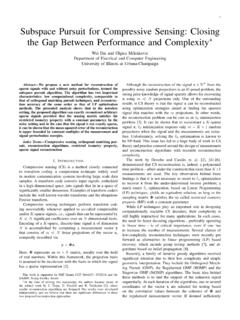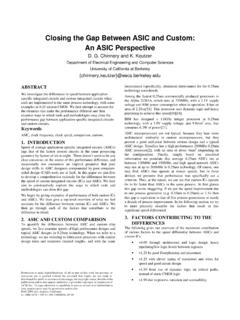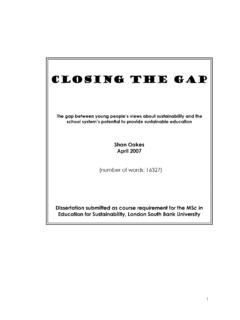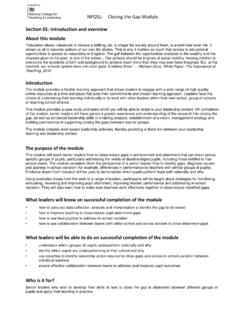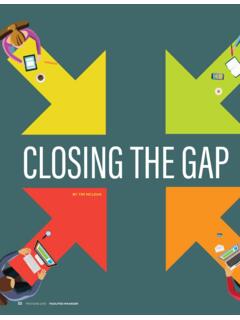Transcription of Closing the Gap Between Technological and Best Practice ...
1 Closing the Gap Between Technological and best Practice Innovations: TPACK and DI Robin A. Millen Principal, Monomoy Regional School District Educational Leadership Doctoral Program Johnson & Wales University Robert Gable Robert K. Gable Center for Research and Evaluation Educational Leadership Doctoral Program Johnson & Wales University _____ 1 Paper presented at the annual meeting of the Northeastern Educational Research Organization, Trumbull, CT, October, 2015. 2 Abstract Implementing differentiated instruction with the fast changing landscape of technology is a complex process (Fullan, 2014; Tomlinson; 2014) and requires widespread diffusion of multiple innovations by educators (Meyer, 2004).
2 However, most classrooms remain stagnant in their attempts to successfully incorporate innovative pedagogies (Darling-Hammond, 2010; November, 2014; Prensky, 2010; Robinson, 2011). Thus Fullan (2014) reported, The time is right to bring together knowledge of systems change, new pedagogies and technologies that allow change to scale through diffusion (p. 13). To understand this problem, this pragmatic, mixed-methods study (Creswell, 2009) collected data through the following condensed research questions: What are the relationships Between educators TPACK and DI self-efficacy and the following demographics: grade level, years of teaching, adopter category, device-student ratio, professional development hours in technology or DI, class size, certification(s), and educational background?
3 How do teachers describe their use of technology to differentiate instruction? A questionnaire with open-ended questions provided quantitative and qualitative data (N=72). Of the respondents, 22% were categorized as innovators and 32% as early adopters-considered teacher leaders. Even though both groups demonstrated more confidence with DI-T than later adopter categories, neither showed significantly stronger TPACK. However, Grade 8-12 teachers demonstrated significantly higher TPACK and self-efficacy to DI than pre-kindergarten to grade 4 teachers.
4 Qualitative themes confirmed the problem. Educators demonstrated misconceptions of TPACK and self-efficacy to DI, and these innovative practices were not successfully being diffused. Thus, recommendations identified specific professional development needs, and for educational systems to create communication channels to more rapidly diffuse innovational pedagogies. 3 Introduction The research on the diffusion of innovations was christened in 1943 with Ryan and Gross agricultural study on the diffusion of seeds (Meyer, 2004).
5 Meyer (2004) and Rogers (2003) pointed out that this study became the framework for all future studies. The characteristics of these studies primarily involved, a) quantitative data, b) concerning a single innovation , c) collected from adopters, d) at a single point in time, and e) after widespread diffusion had already taken place (Meyer, 2004, p. 59). However, this methodology had benefits and limitations (Meyer, 2004), and since innovational, quick-start change is needed in education (Fullan, 1982), more educational research is needed on the diffusion of interrelated innovations (Meyer, 2004, p.
6 2). Elmore (1996) theorized even with as much change as education continually experiences, systemic change would not occur until adaptations in teaching practices were reached. Thus in education, research is needed on both innovative best practices such as differentiated instruction and Technological pedagogical content knowledge (Harris, Mishra, & Koehler, 2009; Meyer, 2004). Problem Statement Most educational change research, to this point, has focused on the diffusion of a single innovation rather than on a technology cluster.
7 The latter defined as a set of interrelated innovations that complement each other in a way that adoption of one innovation might naturally lead to adoption of one or more of the other innovations (Meyer, 2004, p. 60). Effective technology implementation in schools is a complex puzzle. Hundreds of interrelated factors play a role. The presence of computers in a school does not guarantee improved student , the implementation of best practices is as important as the technology itself; and the value of technology in terms of student achievement depends on the quality of its implementation.
8 (Greaves et al., 2010, p. 10) Thus, Fullan (2014) declared, the time Is right to bring together knowledge of systems change, new pedagogies and technologies that allow change to scale through diffusion (p. 13). To increase the rapidity of diffusion of these innovational practices , more stakeholders need to readily communicate and accept innovation throughout school organization. In order to make this happen, teachers, first, need to develop awareness of the Technological infrastructure available (Dede & Richards, 2012; Jacobs, 2010; Jukes, McCain, & Crockett, 2010).
9 Secondly, teachers attitudes must accept the changing dynamics of learning in the 21st century (Harris, Mishra, & McCain, 2009; Jukes, McCain, & Crockett, 2010). Thirdly, teachers must build their Technological pedagogical content knowledge (TPACK) to employ effective best practices , and these practices clearly go hand in hand with differentiated instructional practices . Fourth, a significant shift in how professional development is developed, implemented and assessed must happen to build these capacities (Hofer, Grandgenett, Harris, & Swan, 2011; Jacobs, 2010; West, 2010).
10 Lastly, teachers must not focus on the technology itself, but rather on the learning outcome that is supported by technology (Greenstein, 2012; Harris, 4 Mishra, & McCain, 2009; Jacobs, 2010; Jukes, McCain, & Crockett, 2010). Technological innovations, in practices , ideas, and technology, require wide-spread, second-order change (Fullan, 2014; Houle & Cobb, 2011; November, 2014; Pink, 2005; Robinson, 2010, 2011; Wagner, 2008, 2012). Without educators working to find solutions to instill second-order changes in best practices , ones that will optimize teaching and learning in ways not fully understood, then today s students will be ill-prepared to compete in the global society (Collins & Halverson, 2009; Cunningham, 2009; Friedman, 2005; Houle & Cobb, 2011; Littky & Allen, 1999; Prensky, 2010; Trilling & Fadel, 2009; West, 2011, 2012).


